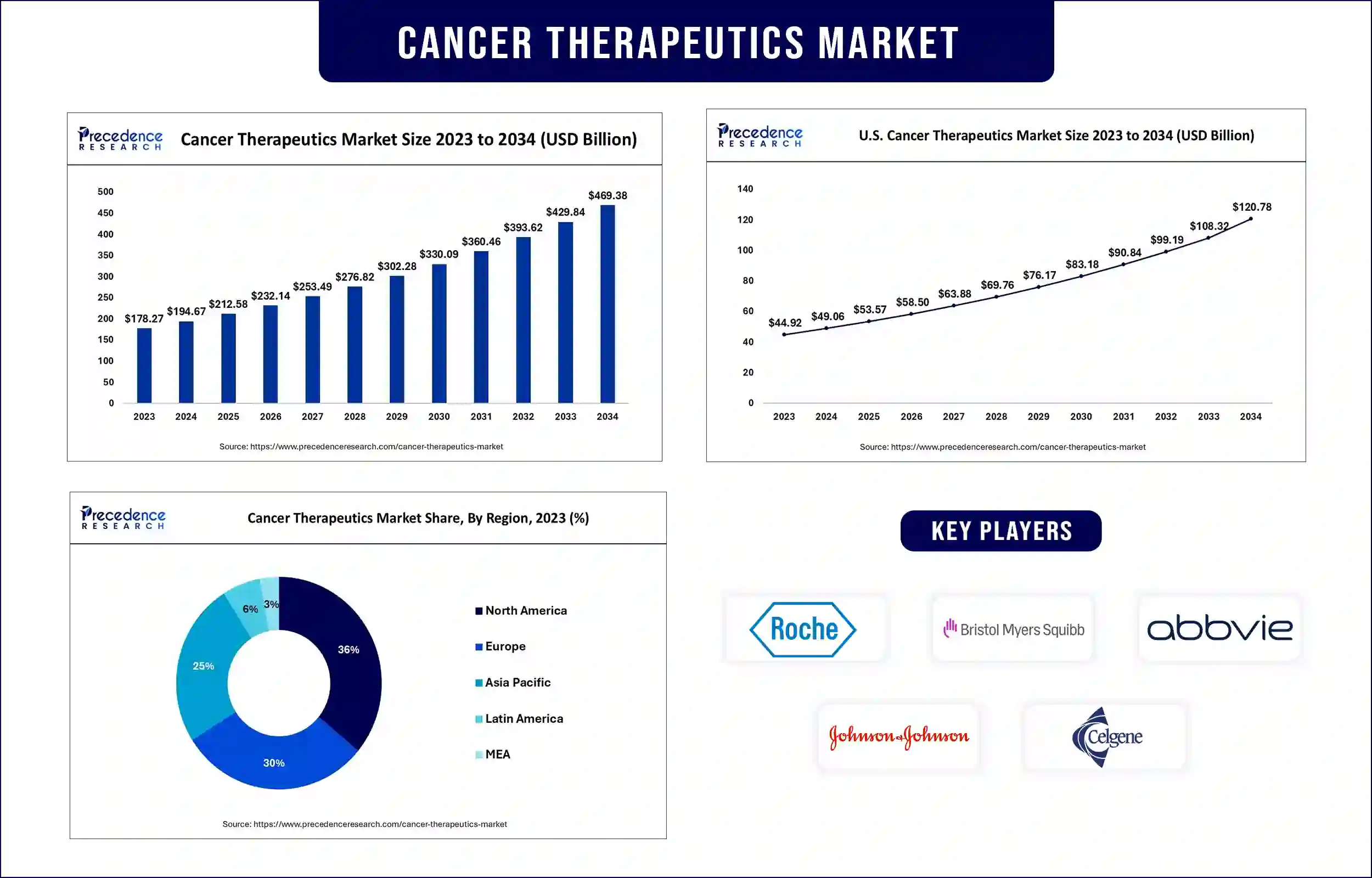April 2025
The global cancer therapeutics market was valued at USD 194.67 billion in 2024 and is projected to reach USD 429.84 billion by 2033, expanding at a CAGR of 9.20% from 2024 to 2033. The demand for cancer therapeutics is rising worldwide due to the invention of targeted therapies, rising cancer research, and increasing prevalence of cancer.

Cancer therapeutics is the treatment to stop or prevent cancer. It includes chemotherapy, radiation therapy, surgery, immunotherapy, and others. There are various types of cancer therapeutics. The therapeutic you receive will depend on the type of cancer you have. Some people will have only one treatment, but some have a combination of treatments, like surgery with chemotherapy and radiation therapy. Biomarker testing is used to provide cancer information. It helps you and your doctor choose a cancer treatment. Chemotherapy uses drugs to kill cancer cells. Hormone therapy slows or stops the growth of breast and prostate cancers that utilizes hormone to grow.
In hyperthermia treatment, body tissue is heated at 113 °F to aid damage and kill cancer cells with low or no harm to normal tissue. Immunotherapy helps your immune system fight cancer. In photodynamic therapy, a drug activated by light is used to kill cancer and other abnormal cells. Radiation treatment uses high doses of radiation to kill cancer cells and shrink tumors. Stem cell transplant helps to restore stem cells that grow into blood cells in individuals who have had their stem cells destroyed by high doses of chemotherapy or radiation therapy.
Surgery is also used to treat cancer, in which a surgeon removes cancer from human body. Targeted therapy targets cancer cells preventing them from growing and spreading. Cancer treatments include various therapies to cure a tumor, shrink it, or stop cancer progression. These therapies are used as primary, adjuvant, or palliative. The immediate treatment removes cancer from human body or kills all the cancer cells. The adjuvant treatment kills any cancer cells that may remain after primary treatment. Palliative treatments relieve the side effects of treatment or signs and symptoms caused by cancer.
Increasing incidence of cancer: The increase in the incidences of all types of cancer fuels the market growth. With the rising mortality rate of cancer, the demand for advanced therapeutics is rising to control. Lung, breast, and prostate cancer are the most common types of cancer. The presence of strong and well-established healthcare infrastructure in developed countries catalyzes market growth.
Rising research and development activities: With the growing burden of cancer cases worldwide, there is a great need for advanced cancer therapies to efficiently treat patients. Thus, governments worldwide are investing heavily in cancer research to develop effective treatments. In line with this, several market players are making efforts to develop effective therapeutics. Rising awareness about early diagnosis: Government entities are launching campaigns for spreading cancer awareness among the population. This, in turn, boosts the demand for early diagnosis and preventive care. Collaborations between government entities and research institutes to spread awareness regarding the availability of innovative and more effective cancer therapeutics, including personalized medicine, boosts the market growth.
North America dominated the cancer therapeutics market with the largest share in 2023, due to the increasing cancer cases, availability of advanced cancer therapeutics, rising investments in research and development, and the growing popularity of personalized medicine. In June 2024, the U.S. National Science Foundation awarded US$ 12.7 million to nine research teams under the Molecular Foundations for Biotechnology (MFB) program. This funding aims to explore the potential of RNA for a range of applications, from cancer treatments to agricultural improvements, highlighting North America's role as a leader in RNA-based therapeutic advancements.
Asia Pacific is projected to be the fastest-growing region in the cancer therapeutics market in the near future due to the rising government initiatives to improve healthcare infrastructure, increasing cases of cancer, rising geriatric population, high consumption of alcohol and tobacco, rising investment in R&D. Moreover, the rising healthcare expenditure, awareness about advanced therapies, and approvals of new treatments contribute to regional market growth.
| Report Attribute | Key Statistics |
| Market Revenue in 2024 | USD 194.67 Billion |
| Market Revenue by 2033 | USD 429.84 Billion |
| CAGR | 9.20% from 2024 to 2033 |
| Quantitative Units | Revenue in USD million/billion, Volume in units |
| Largest Market | North America |
| Base Year | 2023 |
| Regions Covered | North America, Europe, Asia-Pacific, Latin America, and Middle East & Africa |
Segments Covered in the Report
By Application
By Top Selling Drugs
By End User
Get this report to explore global market size, share, CAGR and trends, featuring detailed segmental analysis and an insightful competitive landscape overview@ https://www.precedenceresearch.com/checkout/1546
You can place an order or ask any questions, please feel free to contact at sales@precedenceresearch.com | +1 804 441 9344
April 2025
October 2025
July 2025
July 2025